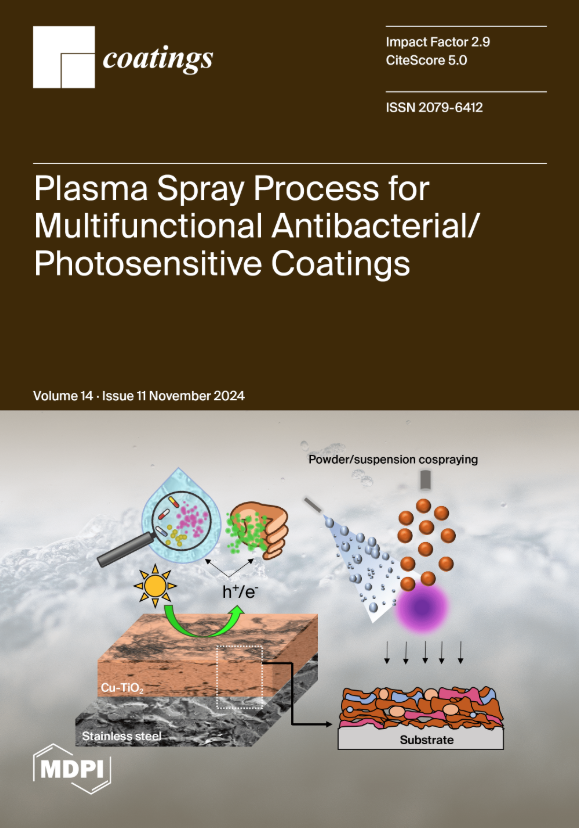Assessment of Warionia saharea Essential Oil as a Green Corrosion Inhibitor for Mild Steel in HCl: Experimental and Computational Studies
IF 2.8
3区 材料科学
Q2 MATERIALS SCIENCE, COATINGS & FILMS
引用次数: 0
Abstract
The objective of this research work is the study of the inhibitory effect of Warionia saharea essential oil (WSEO) on the corrosion of mild steel (MS) in molar HCl solution, employing both experimental and theoretical methods. This inhibitory effect (IE) has been evaluated by using a combination of weight loss measurements (LW) and various electrochemical methods, such as open circuit potential (OCP), potentiodynamic polarization (PDP) and electrochemical impedance spectroscopy (EIS) experiments. The LW results indicated that IE increased with inhibitor concentration, reaching 83.34% at 3.00 g/L. The PDP analysis suggested that WSEO functions as a mixed inhibitor, while in the EIS results the Rct values increased with inhibitor concentration to reach 165.8 Ω cm2 at 2.00 g/L, suggesting a defensive film formation by WSEO molecules over the metallic surface. The thermodynamic study demonstrated that the WSEO molecules adsorption on the MS surface followed a Langmuir isotherm, involving mixed physical and chemical (physicochemical) adsorption on the MS surface. Theoretical methods, including density functional theory (DFT) and molecular dynamics (MD) simulations, were employed to elucidate the inhibition mechanisms of the three main components of WSEO. The quantum chemical analysis, using density functional theory (DFT) and molecular dynamics (MD) simulations, showed a low ΔEgap value of 6.30 eV and a low adsorption energy (Eads) value on an Fe (110) substrate of −258 Kcal/mol for (E)-Nerolidol, indicating the significant contribution of this molecule to the overall corrosion inhibition effect of WSEO. The scanning electron microscope (SEM) analysis verified the presence of a protective film formed by the inhibitor on the MS surface. This study highlights the potential of WSEO as a sustainable and green corrosion inhibitor in acidic environments.将 Warionia saharea 精油作为盐酸中低碳钢的绿色缓蚀剂的评估:实验和计算研究
这项研究工作的目的是采用实验和理论方法,研究 Warionia saharea 精油(WSEO)对盐酸摩尔溶液中低碳钢(MS)腐蚀的抑制作用。通过结合使用失重测量(LW)和各种电化学方法,如开路电位(OCP)、电位极化(PDP)和电化学阻抗光谱(EIS)实验,对这种抑制作用(IE)进行了评估。LW 结果表明,IE 随抑制剂浓度的增加而增加,在 3.00 g/L 时达到 83.34%。PDP 分析表明 WSEO 起着混合抑制剂的作用,而在 EIS 结果中,Rct 值随着抑制剂浓度的增加而增加,在 2.00 g/L 时达到 165.8 Ω cm2,这表明 WSEO 分子在金属表面形成了一层防御膜。热力学研究表明,WSEO 分子在 MS 表面的吸附遵循 Langmuir 等温线,涉及 MS 表面的物理和化学(物理化学)混合吸附。研究采用密度泛函理论(DFT)和分子动力学(MD)模拟等理论方法阐明了 WSEO 三种主要成分的抑制机理。利用密度泛函理论(DFT)和分子动力学(MD)模拟进行的量子化学分析表明,(E)-橙花叔醇在铁(110)基底上的ΔEgap值较低,为6.30 eV,吸附能(Eads)值较低,为-258 Kcal/mol,表明该分子对WSEO的整体缓蚀效果有重要贡献。扫描电子显微镜(SEM)分析验证了抑制剂在 MS 表面形成的保护膜的存在。这项研究凸显了 WSEO 作为酸性环境中可持续绿色缓蚀剂的潜力。
本文章由计算机程序翻译,如有差异,请以英文原文为准。
求助全文
约1分钟内获得全文
求助全文
来源期刊

Coatings
Materials Science-Surfaces, Coatings and Films
CiteScore
5.00
自引率
11.80%
发文量
1657
审稿时长
1.4 months
期刊介绍:
Coatings is an international, peer-reviewed open access journal of coatings and surface engineering. It publishes reviews, research articles, communications and technical notes. Our aim is to encourage scientists to publish their experimental and theoretical results in as much detail as possible. There is no restriction on the length of the papers. Full experimental and/or methodical details must be provided. There are, in addition, unique features of this journal:
* manuscripts regarding research proposals and research ideas will be particularly welcomed
* electronic files or software regarding the full details of the calculation and experimental procedure - if unable to be published in a normal way - can be deposited as supplementary material
 求助内容:
求助内容: 应助结果提醒方式:
应助结果提醒方式:


